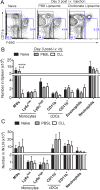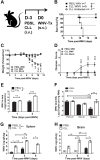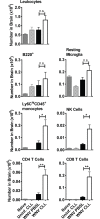Splenic macrophages are required for protective innate immunity against West Nile virus
- PMID: 29408905
- PMCID: PMC5800658
- DOI: 10.1371/journal.pone.0191690
Splenic macrophages are required for protective innate immunity against West Nile virus
Abstract
Although the spleen is a major site for West Nile virus (WNV) replication and spread, relatively little is known about which innate cells in the spleen replicate WNV, control viral dissemination, and/or prime innate and adaptive immune responses. Here we tested if splenic macrophages (MΦs) were necessary for control of WNV infection. We selectively depleted splenic MΦs, but not draining lymph node MΦs, by injecting mice intravenously with clodronate liposomes several days prior to infecting them with WNV. Mice missing splenic MΦs succumbed to WNV infection after an increased and accelerated spread of virus to the spleen and the brain. WNV-specific Ab and CTL responses were normal in splenic MΦ-depleted mice; however, numbers of NK cells and CD4 and CD8 T cells were significantly increased in the brains of infected mice. Splenic MΦ deficiency led to increased WNV in other splenic innate immune cells including CD11b- DCs, newly formed MΦs and monocytes. Unlike other splenic myeloid subsets, splenic MΦs express high levels of mRNAs encoding the complement protein C1q, the apoptotic cell clearance protein Mertk, the IL-18 cytokine and the FcγR1 receptor. Splenic MΦ-deficient mice may be highly susceptible to WNV infection in part to a deficiency in C1q, Mertk, IL-18 or Caspase 12 expression.
Conflict of interest statement
Figures








Similar articles
-
West Nile Virus Infection Blocks Inflammatory Response and T Cell Costimulatory Capacity of Human Monocyte-Derived Dendritic Cells.J Virol. 2019 Nov 13;93(23):e00664-19. doi: 10.1128/JVI.00664-19. Print 2019 Dec 1. J Virol. 2019. PMID: 31534040 Free PMC article.
-
MAVS Is Essential for Primary CD4+ T Cell Immunity but Not for Recall T Cell Responses following an Attenuated West Nile Virus Infection.J Virol. 2017 Feb 28;91(6):e02097-16. doi: 10.1128/JVI.02097-16. Print 2017 Mar 15. J Virol. 2017. PMID: 28077630 Free PMC article.
-
Interferon regulatory factor 5-dependent immune responses in the draining lymph node protect against West Nile virus infection.J Virol. 2014 Oct;88(19):11007-21. doi: 10.1128/JVI.01545-14. Epub 2014 Jul 16. J Virol. 2014. PMID: 25031348 Free PMC article.
-
Innate and adaptive immune responses determine protection against disseminated infection by West Nile encephalitis virus.Viral Immunol. 2003;16(3):259-78. doi: 10.1089/088282403322396082. Viral Immunol. 2003. PMID: 14583143 Review.
-
Role of Immune Aging in Susceptibility to West Nile Virus.Methods Mol Biol. 2016;1435:235-47. doi: 10.1007/978-1-4939-3670-0_18. Methods Mol Biol. 2016. PMID: 27188562 Free PMC article. Review.
Cited by
-
Innate Immune Response of Primary Human Keratinocytes to West Nile Virus Infection and Its Modulation by Mosquito Saliva.Front Cell Infect Microbiol. 2018 Nov 2;8:387. doi: 10.3389/fcimb.2018.00387. eCollection 2018. Front Cell Infect Microbiol. 2018. PMID: 30450338 Free PMC article.
-
Discrete viral E2 lysine residues and scavenger receptor MARCO are required for clearance of circulating alphaviruses.Elife. 2019 Oct 9;8:e49163. doi: 10.7554/eLife.49163. Elife. 2019. PMID: 31596239 Free PMC article.
-
Effect of silkworm peptide on inducting M1 type polarization and Th1 activation via TLR2-induced MyD88-dependent pathway.Food Sci Nutr. 2019 Mar 12;7(4):1251-1260. doi: 10.1002/fsn3.954. eCollection 2019 Apr. Food Sci Nutr. 2019. PMID: 31024698 Free PMC article.
-
A case of West Nile virus encephalitis accompanied by diabetic ketoacidosis and rhabdomyolysis.IDCases. 2019 Feb 13;15:e00505. doi: 10.1016/j.idcr.2019.e00505. eCollection 2019. IDCases. 2019. PMID: 30815360 Free PMC article.
-
Interleukin-17A signaling promotes CD8+ T cell cytotoxicity against West Nile virus infection through enhancing PI3K-mTOR-mediated metabolism.PLoS Pathog. 2025 Jul 9;21(7):e1013218. doi: 10.1371/journal.ppat.1013218. eCollection 2025 Jul. PLoS Pathog. 2025. PMID: 40632810 Free PMC article.
References
-
- Petersen L. R., Brault A. C., and Nasci R. S. 2013. West Nile virus: review of the literature. JAMA. 310:308–15. doi: 10.1001/jama.2013.8042 - DOI - PMC - PubMed
-
- Roehrig J. T. 2013. West nile virus in the United States—a historical perspective. Viruses. 5:3088–108. doi: 10.3390/v5123088 - DOI - PMC - PubMed
-
- Murray K. O., Ruktanonchai D., Hesalroad D., Fonken E., and Nolan M. S. 2013. West Nile virus, Texas, USA, 2012. Emerg. Infect. Dis. 19:1836–8. doi: 10.3201/eid1911.130768 - DOI - PMC - PubMed
-
- Beasley D. W., Barrett A. D., and Tesh R. B. 2013. Resurgence of West Nile neurologic disease in the United States in 2012: what happened? What needs to be done? Antiviral Res. 99:1–5. doi: 10.1016/j.antiviral.2013.04.015 - DOI - PubMed
-
- Diamond M.S. 2009. Progress on the development of therapeutics against West Nile virus. Antiviral Res. 83:214–27. doi: 10.1016/j.antiviral.2009.05.006 - DOI - PMC - PubMed
Publication types
MeSH terms
Grants and funding
LinkOut - more resources
Full Text Sources
Other Literature Sources
Research Materials
Miscellaneous

